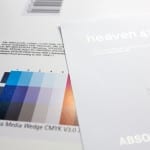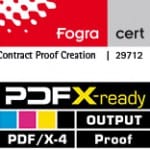Since 2009 PSOUncoated has been the standard profile for uncoated paper. Nevertheless, proof service providers often have the problem that at first glance proofs on PSOUncoated often differ significantly from the print result. Immediately visible: the white point of the paper.
The PSOUncoated paper white looks very grayish. If, for example, PSOUncoated is proofed on an EFI 9120 XF paper, which actually has a neutral white coloration as paper, then the paper must be recolored by the printer in terms of paper white. This paper-white simulation makes the proof look “grayish” and often not “bright white” like the real production paper. “I can’t put this down to my client” proof service providers often hear from the agencies and designers who commission proofs. And frankly, printing on bright white uncoated paper will also differ significantly from the PSOUncoated Proof result depending on the paper selected.
Some proofing services still proof uncoated paper according to ISOUncoated, because the paper tone is much whiter and not so grayish. In the medium term, however, this will not overcome the misery: PSOUncoated is the current standard according to which the process standard for offset printing certified print shops are also based. But in the pressroom the differences between norm and reality often become apparent. If the new D50 standard light according to ISO 3664:2009 with higher UV components is used for inspection at the printing table, then proof and printing result can often only be matched very poorly. And due to the long standardization periods, this problem will continue to accompany printers and proofing service providers for quite some time to come.

Today I received an email in which PANTONE asked how it should orientate its products and services in the future. The users were asked which countries, industries and company sizes they come from, but also what PANTONE products should look like in the future and what customers would be prepared to pay for PANTONE services in the future. Question: How much can PANTONE services cost? PANTONE appears to be orientating itself on the PANTONE Connect prices: All price queries have the lowest price category < $ 7,- / month, i.e. … read more

Even almost 9 years after the introduction of the successor colour space PSOCoatedV3, ISOCoatedV2 / FOGRA39 is still the most widespread colour space in Europe. We at Proof GmbH count around 200 jobs from time to time for the German Printing and Media Industries Federation, among others. In the last count, proofs in ISOCoatedV2 accounted for around 68% of all proof jobs at our company. This is a clear sign of the continued widespread use of the colour space. ISOCoatedV2: From the classic colour space to the beacon of the … read more

The Proof GmbH provides proofs for Scheufelen Heaven 42 papers on the new EFI 8245 OBA proofing paper. With this new proofing paper it is now possible to proof the bright-white paper dye of Heaven42l. With Heaven 42 a bright white paper was developed by the German paper company Scheufelen, which opened up a new color whiteness. Especially technical motifs (shades of gray, silver tones from 4c, strong contrasts) act on Heaven 42 particularly brilliant and neutral. With an unchanged separation (eg with ICC profile “ISOcoated_v2”), but the printed image with the … read more

Once again we passed the Fogra certifications and were even the first company to be certified with the Fogra “Spot cert” for Fogra59 eciCMYK-V2.

With long delay, the new printing conditions Fogra Fogra 51 and 52 – PSOCoatedV3 and PSOUncoatedV3 – will be presented at the end of September and finally come into practice. The German bvdm invites together with Fogra and ECI to a joint “kick-off” of the new printing conditions in the “Hochschule der Medien” in Stuttgart. On Wednesday, the 30th of September 2015 from 10 o’clock representatives of the associations will introduce in the university the innovations, Karl Michael Meinecke wrote of the ECI mailing list. In this kick-off the new, jointly developed printing conditions … read more

Digimarc is a digital watermark that can be used to embed information in images, videos or other media. Digimarc watermarks are invisible to the human eye, but remain recognisable to special software or devices. Digimarc is becoming increasingly popular in the packaging sector in particular, as this technology allows the digits of the EAN barcode and more to be applied invisibly to all areas of the packaging. Digimarc and EAN barcode at the supermarket checkout When scanning at the checkout, the checkout staff do not have to search for the … read more

Proof GmbH has again been certified by Fogra in September 2015, this time for the standards Fogra 51 (PSOCoated_v3), Fogra 52 (PSOuncoated_v3) and Fogra 39 (ISOcoatedv2). The Proof GmbH has thus reaffirmed it’s quality by the strict criteria of Fogra. The tests Fogra conducted went far beyond the pure colorimetric readout of a media wedge. The special proofs for Fogra were evaluated among the following criteria: Color accuracy of the Ugra / Fogra media wedge CMYK 3 Overall color accuracy and gamut Uniformity and homogeneity of the proofsProof GmbH has again been certified … read more

We spectrally measured the paper white tone and the proportion of optical brighteners of over 1,000 papers of the most important paper manufacturers such as Berberich and Papier Union as well as online printing companies such as Flyeralarm and wir-machen-druck.de. Only a few paper manufacturers currently publish data on paper whiteness and the proportion of optical brighteners in their papers, but only technical indicators such as whiteness according to ISO 2470-2 or CIE ISO 11475. However, designers can hardly record paper whiteness with these values. In addition, it is not … read more

In this short image video we – the Proof GmbH – introduce us and our work. Find out who we are and what drives us. What do you think of our short film?

Offset and Newsprint ISO Coated v2 (ECI) / ISO Coated v2 300% (ECI) Profile: ISOcoated_v2_eci.icc Standard for glossy and matte coated paper Paper: Types 1 and 2, gloss and matte coated Tone value increase curves A (CMY) and B (K) as defined in ISO 12647-2:2004 Characterisation Data: FOGRA39L ISOUncoated Profile: ISOUncoated.icc Standard for uncoated white natural paper Paper: paper grade 4, uncoated white offset, dot gain curves C (CMY) and D (K) from ISO 12647-2: 2004 Characterisation Data: FOGRA29L PSOCoatedV3 / Fogra 51 Profile: PSOcoated_v3.icc The successor of ISOCoatedV2 for glossy … read more








